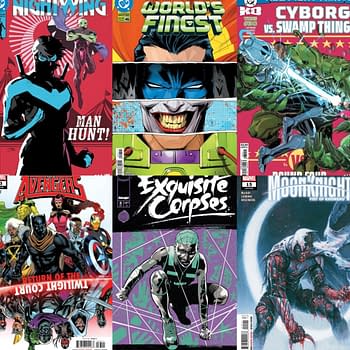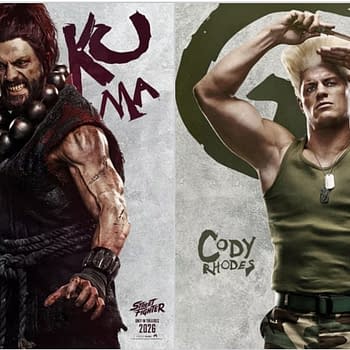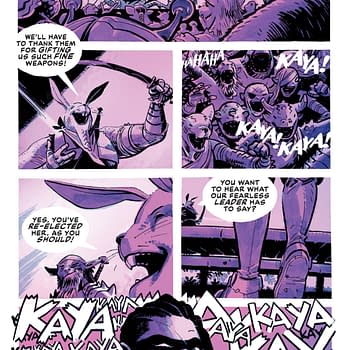Posted in: Ablaze Publishing, AfterShock, Ahoy, Antarctic Press, Archie, AWA, Bad Idea, Black Mask Studios, Boom, Comics, Comics Publishers, Current News, Dark Horse Comics, DC Comics, Dynamite, Fantagraphics, IDW, Image, Marvel Comics, Oni Press, Opus Comics, Rebellion / 2000AD, Titan, Top Cow, Valiant, Vault, Viz Media, Yen Press | Tagged: bestseller list, marketshare, sales chart
The Comics Industry Suffers Without A Proper Sales Chart
For years, industry pundits argued to end Diamond’s monopoly. The price of getting what you want is getting what you once wanted.
Do you know what the best-selling comic book is right now? And what about the sales of the top comic book publishers? We know in the direct market they will be Marvel and DC, most than likely in that very order, but beyond that… is Image still holding firm at number three? Or is it Dark Horse? Or maybe Boom? IDW or Dynamite? Hell, maybe Frank Miller Presents has had a bump?
But why would you know? And how could you? There hasn't been anything resembling an industry-wide sales chart since DC left Diamond for Lunar in 2020. For a while, the Bleeding Cool Bestseller Lists totted up sales at a number of representative stores, but without extra funding, I was unable to motivate enough stores to keep participating. I have now made a deal to extrapolate sales data from ComicHUB comic book stores orders, so far, it's limited to a weekly top ten, with a ratio of one sale to another, but nothing more and no market share. There hasn't been any truly reliable sales information regarding even Diamond's offerings in the direct market since the last truncated Diamond chart well over a year ago. The best indication we have of how individual titles are doing is the near-endless stream of press releases announcing first-issue sellouts and the reprints that inevitably follow, but what does that tell us beyond that?

With Marvel, Dark Horse, and IDW now ensconced at Penguin Random House, DC and now Image at Lunar, Boom and Dynamite at Diamond, and with most everyone else split in some way between the latter two distributors, the industry has never seemed more fractured. For years, industry pundits argued in favour of ending Diamond's distribution monopoly, but now that it's happened, it's hard to avoid the fact that, at least in the short term, it seems to be stifling the flow of sales information.
On one hand, it could be argued that removing market share and sales stats from the equation creates an environment in which comics and graphic novels can succeed solely on their merits. Instead of speculators greedily scooping up copies of top sellers specifically because they're earmarked for success, there's an opportunity for things to thrive based on the quality of the stories and the art. Surely, if we look at the past, everything from Fantastic Four to Sandman to Bone to The Walking Dead has become not just successful, but massively so, despite starting off with limited expectations. Nobody was concerned with how those comics were ordered pre-release, they just cared that they were good.
But on the other hand, as ideal as that scenario may be for prospective readers, it puts both the retailer community and, I would wager, the creative community at something of a disadvantage.
A little knowledge is a dangerous thing.
Speaking to one industry insider, it was relayed to me that during a recent discussion with a group of retailers, it became apparent they all had differing perspectives on what a specific publisher's most recent hit was, as well as what even constituted a hit in today's marketplace. When the publisher shared actual numbers with them, many of the retailers were genuinely shocked, because they could only draw from their own experiences with the titles in question. Some stores were surprised that certain titles sold more than they thought possible based on their own sales data; others were sure various things had to be selling less. Everyone agreed there was a missed opportunity to sell more, but faced with a total blackout of sales information, the only information they could trust was the information generated within their own stores.
My understanding is that from a publishing perspective, there is a feeling that the information is out there, and that retailers have opportunity to order up when something sells out and goes back to press. We all hear about how well Something Is Killing The Children is doing issue over issue, after all – when orders go up, those insider tongues at Boom understandably begin to wag over at Bleedin Cool, and when even those orders aren't enough to satisfy demand, out go the press releases and up go the order codes for the second or third printings. Like clockwork. Image Comcis has seen similar with Local Man and Eight Billion Genies.
Talking of Image Comics, when something like The Walking Dead catches lightning in a bottle and starts an uphill climb from sales of under 10,000 – retailers need more than publisher hype to gauge their orders. Actually seeing a record of improvement can be the difference between having the confidence to double an order quantity or simply waiting to see how customers react, and in some cases, waiting even a month can be too long on some surprise hits.
But the absence of sales charts keeps more than just the retailers in the dark—letting the various publishers' PR machines drive the narrative means that even the creators can have a warped impression of what does well in the market. One publishing source shared a story about a creator who was under the impression that a specific list of other creators were enjoying higher sales on their titles. This prompted an outlay of data from Bookscan that illustrated that said creator was actually doing substantially better across the board than the group of others— not just on recent releases, but on books from their back catalogue as well. There's obviously some level of difference between book market stats and what sells in comic book stores, plus Bookscan data isn't accessible to everyone, but that underscores the fact that in the absence of sales charts from Direct Market distributors, creators are forced to do a lot of guesswork.
Nature abhors a vacuum.
It's not just the publishers who can control the narrative when there are no sales numbers to cross-check against. Take a look at Mark Millar, a creator who has built his entire personal brand around being a showman of sorts, a modern day Stan Lee. Sure, that's displayed with flashy blockbuster adaptations on his resume, but it's also a crutch we've seen him use time and time again to mesmerise his fanbase with an otherwise lacklustre offering like… um, I mean, does anyone remember Sharkey? So we heard the cymbals clang for Prodigy, the trumpet sound for The Ambassadors, and the drum beat for Night Club, yet all of those series seemingly fizzled on contact with oxygen. Now, my own sources tell me that Big Game with the astonishing Pepe Larraz actually ended up being Millar's bestselling Image title since Prodigy in 2018, which clocked in at just under 50,000, meaning everything since was ordered at a lesser amount, although how much less is open to speculation without actual numbers. Two things here: Without sales numbers to refer to the industry must rely on the bombast. And when the bombast gets old, and the readers get wise… then the industry simply moves on from the showman type.
Because Mark Millar knows how important the sales chart is as well, as he attempted to fix it once with a bulk giveaway order for The Magic Order #1…
Speaking of showman types, the days of Donny Cates topping the Diamond charts with multiple books at Marvel seems like a distant memory at this point – and not just because Donny hasn't been as active as he once was. Were his King In Black, Venom and Thor triumphs happening today, there would be no official documentation of it.
And so it goes for any number of the industry's biggest names. Was Todd McFarlane and Greg Capullo's Batman/Spawn the biggest sales success of 2022? How did Dark Crisis really do? Was Jonathan Hickman's Inferno a blazing success or just left ashes? How did Jason Aaron's Once Upon A Time At The End Of The World stack against his other creator-owned work from Vertigo and Image? Has Dark Horse proven to be the key to success Brian Michael Bendis has been looking for since turning his back on Marvel? Just how badly did his sales suffer at DC.
Your days are numbered.
The truth of the matter is that nobody knows, which would be unthinkable in any other entertainment industry.
Whether it's movies, television, streaming, radio, music, books – there are statistics to illustrate success and failure. Those are the metrics that both companies and talent live and die by, and even though it could be argued those are all much larger industries – the North American comics market is estimated at $2 billion. A complete absence of information regarding what is and isn't doing well is not only remarkably unhelpful, it actually reinforces the notion that comics matter little beyond being adaptation fodder for other more successful media.
Bleeding Cool will be doing its best to try and bring you something. The first two Weekly Top Ten Bestseller Lists are a start, and we will be running a Top Ten Monthly Bestseller List on the 1st of September. But we'd love to find a way to do Top 100, Top 300 monthly lists with estimated order numbers of sell through numbers, as well as monthly marketshare – and an annual version too. What I've been able to do now, haa taken me a year to negotiate. I need to find a way to do more…

















